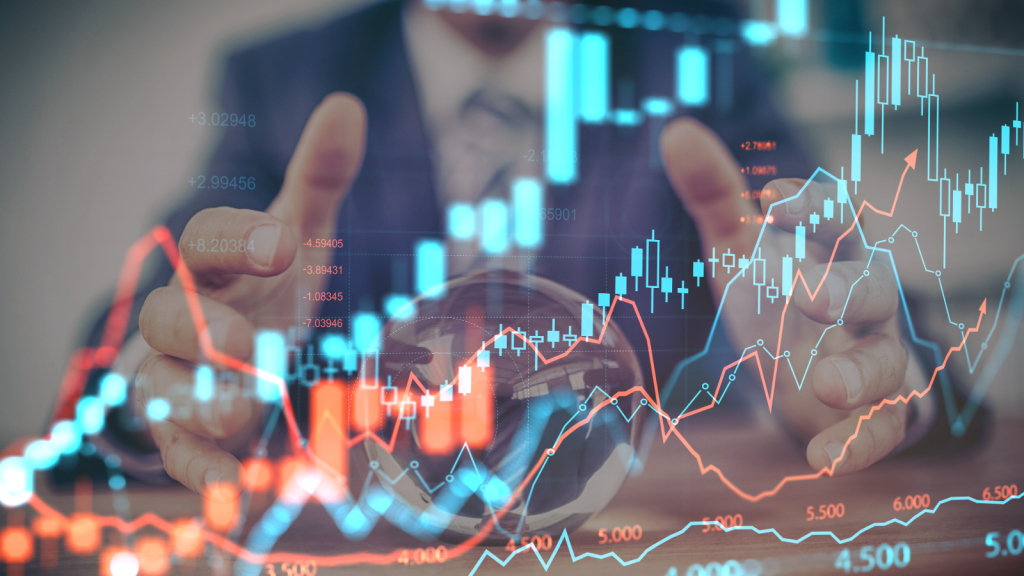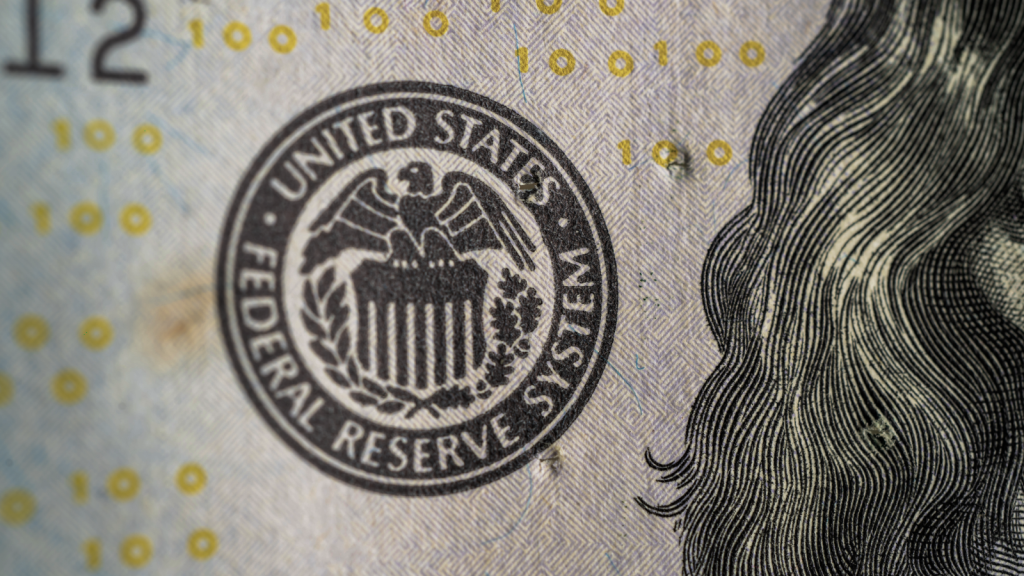Editor’s Note: At the Federal Open Market Committee meeting yesterday, Federal Reserve Chair Jerome Powell said they’re keeping interest rates at the target range of 4.25% to 4.5%. They’re standing pat.
The Fed Chair finds himself in a tough spot because the trade war creates two different risks to the economy. On the one hand, the trade war could knock the economy into recession, which would demand lowering rates. On the other hand, the trade war could reignite inflation, which would demand raising rates. Since it’s too early to know which risk the economy might face, Powell and the FOMC are standing still. They’re not in panic mode. I believe that’s the correct position.
My InvestorPlace colleague Louis Navellier, on the other hand, offers a different perspective worth considering. You can hear Louis’ take in this video, where he sits down with InvestorPlace Editor-in-Chief Luis Hernandez to talk about the Fed’s decision. Louis also lets us know how he believes investors can profit regardless of what’s happening in the market. Over to you, Louis…
The Federal Reserve concluded its latest policy meeting yesterday. And, as expected, it made no change to key interest rates.
In its official policy statement, the Fed cited that inflation “remains somewhat elevated.” And in his press conference, Fed Chair Jerome Powell reiterated the Fed’s “patient” approach, saying, “We think right now the appropriate thing to do is to wait and see how things evolve. There’s so much uncertainty.”
I find this to be contradictory and a little perplexing. That’s because deflationary signs are popping up everywhere. Meanwhile, the uncertainty around trade is dissipating.
Just this morning, for example, President Trump announced a new trade deal with the United Kingdom. I expect more of these deals to be announced in the coming days.
We even recently learned that negotiations between the U.S. and China will begin this weekend in Switzerland.
So, what’s keeping the Fed from cutting rates, and when can we expect the next cut?
That’s one of the questions I answer in a special video interview with Luis Hernandez, Editor-in-Chief of InvestorPlace. I also explain what to make of the Fed’s inaction – and how investors can profit regardless of what’s happening in the market.
Now, you might be surprised to learn what I have to say. That’s because, to be honest, I’m very frustrated with our central bank.
Just click below to watch this video. You can also read the full transcript below.
Now, the bottom line is that the Fed will be forced to cut rates sooner or later, because the reality is we’re in the middle of a global interest rate collapse.
From the European Union to the U.K. to China, central banks are slashing rates to combat slowing growth or outright recessions.
Because our market rates are higher, capital is flowing into the U.S., which is pushing down the rates on our Treasuries. And the Fed can’t fight market rates forever, folks.
That’s why I have gone on record predicting four rate cuts this year. And even after the Fed’s decision yesterday to hold steady, I stand by my prediction.
With the big Fed news now behind us, it’s time for investors to turn their attention back to the first-quarter earnings season.
According to FactSet, 72% of S&P 500 companies have released quarterly results. Of those, 76% have exceeded analysts’ earnings expectations. The average earnings surprise is 8.6%, and the S&P 500 is expected to achieve 12.8% earnings growth for the quarter.
These are great numbers, but I’m proud to say that my Accelerated Profits stocks are doing even better.
So far, the average Accelerated Profits stock earnings surprise is an impressive 32%. My Buy List is currently characterized by 39.1% average forecasted earnings growth and 24.1% average forecasted sales growth. And thanks to positive analyst revisions, I expect wave after wave of positive results in the upcoming weeks to dropkick and drive my stocks higher!
Thanks to my stocks’ superior fundamentals, they don’t need the Fed to cut rates to do well in this market.
If you don’t want to wait for the Fed or big economic news to boost your gains and give you real cash in your pockets now, then you’ll want to consider Accelerated Profits.
This is my fastest-moving stock-trading service, designed to deliver quick gains regardless of what’s happening in the market. In fact, over the past year or so, my subscribers had the chance for gains like…
- 106.44% from Alamos Gold Inc. (AGI)
- 70.22% from GigaCloud Technology Inc. (GCT)
- 604.81% from Vista Oil & Gas (VIST)
- 135.05% from CECO Environmental Corp. (CECO)
- 114.49% from Targa Resources Corp. (TRGP)
And now, my system has identified the companies best positioned to thrive during the next wave of the AI Revolution – what I’m calling the Trump/AI Convergence.
Click here to learn more now.
Regards,
Louis Navellier
Editor, Market 360
Louis hereby discloses that as of the date of this email, Louis, directly or indirectly, owns the following securities that are the subject of the commentary, analysis, opinions, advice, or recommendations in, or which are otherwise mentioned in, the essay set forth below:
Alamos Gold, Inc. (AGI), CECO Environmental Corp. (CECO) and Targa Resources Corp. (TRGP)
Transcript
Luis Hernandez: Hi, I’m Luis Hernandez, Editor-in-Chief at Investor Place.
The market has felt like it was on hold this week waiting for yesterday, the conclusion of the Federal Reserve Open Market Committee (FOMC) meeting, and a decision on interest rates.
Going into the meeting, the stock market was not expecting any rate cuts, and that’s just what they got. But everyone was listening closely to Fed Chairman Jerome Powell’s press conference to see if there were any hints of rate cuts coming in June or July.
As you probably know, President Donald Trump has been pressing the Fed for rate cuts. Just this Sunday, Trump again said that Powell should lower rates now, even as the odds of a cut were close to zero.
Today, I’m here with stock market legend, Louis Navellier, to talk about what Powell said, when he thinks rate cuts will come and what the market will do when they finally appear. We’ll also talk about stock market earnings, what Louis expects for his stocks over the next few quarters and general market conditions.
Louis, thanks for taking the time.
Louis Navellier: Good to be here.
Luis Hernandez: Okay, the Fed met the market’s expectations by not cutting rates, leaving short-term interest rates between 4.25 and 4.5%, where it’s been since December.
I know you think this is a mistake. Can you summarize for folks why you think it is such a mistake?
Louis Navellier: Well, there’s two reasons.
One is the Fed’s way above market rates, based on the two-year treasury. They have to cut twice to get in line with market rates. And then, we have deflation. So we had deflation in the last two CPIs (Consumer Price Index), the last PPI (Producer Price Index). PCE (Personal Consumption Expenditures) came in flat as a pancake. Most of our inflation in America has been tied to housing costs. And home builders have to discount homes to sell them.
I’m in Reno now, where they have quite a bit of new home building. And it’s always, “Let’s make a deal.” The prices keep falling, from Toll Brothers Inc. (TOL) and whoever’s building out here. And that’s all over the country.
The only good green shoot is they seem to be worried about unemployment. And they should be, because new claims for unemployment shot up. Some people thought that was a spring break distortion, but the payroll report clearly didn’t show all the DOGE (Department of Government Efficiency) cuts, so that’s going to get worse in the upcoming months.
So hopefully, they cut rates to fix the unemployment situation. In the meantime, rates are going to continue to collapse in Europe. The ECB (European Central Bank) has cut seven times, but they got another cut brewing. I’m still on record that the Fed will cut four times this year, because I was envisioning this global collapse in interest rates. And that is happening.
The worst rates are, of course, China, where rates are below Japan. And China also had some stimulus today, trying to save their economy. But they’re so bad that everybody keeps talking about a currency devaluation.
So, the whole world is at or near a recession right now. Asia is doing very poorly. Mexico’s in a recession, so is Canada, so is Britain, so is France, so is Germany.
And the only country that is not is us. Now, I know our GDP (Gross Domestic Product) went down, but we had a 4.8% surge from imports. Imports were up 41.3% in the first quarter, so that caused a big GDP adjustment of 4.8%, actually. And then you have to adjust it for the inventories that are still sitting around. So if we back that out, we’re not in a recession.
If you’re a manufacturer or somebody around the world, you better move to America fast. And I was dealing with some Germans today, and they like to remind me that my AfD comments are out of bounds, but I said, “AfD at least wants to turn your nuclear plants back on. And that would save your manufacturing flight.”
But if you’re sitting there in Germany and you’re a BMW, Mercedes Benz Group ADR (MBGYY) or Volkswagen Group (VWAGY), you have to be all EVs by 2035, according to EU (European Union). Or you can just pick up and move all your manufacturing to America. Our electricity is a fourth of the cost in Germany. Trump says he’ll give you visas for all the workers you want to move.
We have five southern states that will be throwing incentives at you, and that’s going to make it very lucrative. And now you can build your ice engines, or your internal combustion engines that you’d have to shut down in Europe.
So we’re just an oasis amidst a very confusing time. And I guess my last frustration is, okay, I know Ford Motor Co. (F) raised the price of the Mach-E and the Bronco by two grand. They’re made in Mexico. That’s that. I know GM (General Motors Co.) is actually the largest importer of foreign cars, mostly from Korea, but last year they brought in 55,000 cars from China. So I know some of our companies are struggling with the new rules, but the truth of the matter is that we’re it. I mean, we have household formation. We assimilate our immigrants no matter how they get here. We got 50 states fighting for your business.
It doesn’t matter who we elect, we’re going to be the oasis. And we’re going to have freer trade around the world when all this is done. Even China had dropped their tariffs on over a hundred items. And of course, China’s meeting with Scott Bessent in Switzerland on the weekend.
So I’m very bullish. I happen to have a car on a boat coming over, and they’re not going to ding me because they’re anticipating they’re going to work something out. And that’s good.
Luis Hernandez: Yeah. So I know that you’ve been tracking some of the manufacturing that’s coming back to the United States. Do you have an updated figure on that?
Louis Navellier: Well, it was well over $7 trillion. I’m sure it’s going to take a few years, but the data centers are the first, because they should have their data here, because we have the cheapest electricity.
Data centers go wherever there’s cheap electricity. So that’s hydroelectric, Columbia River Gorge, Hoover Dam, hydroelectric. Wherever there’s nuclear plants. There’s a lot of them in North Carolina. Chattanooga is probably the cheapest, they got hydro and nuclear there.
Also, you have to have super fast internet. I’m in Reno here. We have fast internet because we have the Apple Inc. (AAPL) and Google server farms here.
So it’s going to be very exciting how we build out this AI database. But so far, so good. The only glitch has been that Super Micro Computer, Inc. (SMCI) said that some of their customers want the Blackwell chip instead of the H20 chip. So in March, their sales stalled a bit. And there’s still some fuzziness on their sales guidance. But they’re still the leader on building the water-cooled rack system. So that’s why I’m holding the stock.
Luis Hernandez: So in the first quarter, or at least in the first earnings season here, the results have been pretty good, even as the tariff story has weighed on the markets. What’s your observation about earnings season so far, and how your stocks did?
Louis Navellier: It’s been stunning. But we have some stocks that announced, and they get hit with profit-taking. We had one, Powell Industries Inc. (POWL) beat on sales, but the headline says they missed, they beat. Somebody made an error, so it got hit by the algorithm. So POWL is a good buy.
But, yeah, some of the stocks are getting hit with profit-taking. Probably the most obvious one was Brinker International Inc. (EAT), the restaurant chain. Not only did they beat, they also got higher. So you see nervous people taking profits in stocks, but all good stocks bounce. Anytime you see that phenomenon, it usually will bounce in a few days.
Gold stocks are screaming right now. We had one, Kinross Gold Corp. (KCG, they beat and then they shot up.
So I’m happy the earnings down some season, but the guidance is a little bit more muddled because there seems to be a concern. Obviously, consumer confidence has been devastating. I go off mostly the conference board survey, not the Michigan survey – the University of Michigan survey. Conference board is much better, but they did report a big plunge.
So we just got to cheer up as a country. I think Scott Bessent is wonderful for that. He’s kind of the don’t worry, be happy Treasury Secretary. And if he’s not nervous, we shouldn’t be nervous. We had the treasury yields declining after the FOMC statement, so that’s a good sign.
But we’ve been finding a negative media emanating from Europe. [Ed] Yardini had a good piece, where he had four Economist Magazine covers all negative about America. And I can tell you that the Financial Times is also negative. So Economist and Financial Times are based in Britain.
But just because they’re miserable doesn’t mean we should be miserable. I’m sorry that half the country can’t pay their utility bill, and they have to be subsidized. And I’m sorry you got problems with assimilating your new immigrants and all, but we’re not them.
Luis Hernandez: Yeah.
Louis Navellier: And I was very curious with Mark Carney’s visit to the White House. Obviously, Trump praised him, as he did with Kurt Steiner when he came to the White House. But then, Trump always gets his little digs in, like, “Don’t give up on that 51st state thing, because…”
Luis Hernandez: Yeah, yeah.
Louis Navellier: “… we’ll drop all the tariffs and then you’ll prosper.”
Luis Hernandez: Yeah, yeah.
Louis Navellier: That was, I guess he just has to a have a marker on everybody.
But really, when you look back on it, every major multinational has to outsource to America. And there’s other things going on, like India is picking up business from China, via Foxconn, Apple’s business and stuff. So it’s interesting.
Luis Hernandez: Yeah. You mentioned that I think the other big story that I’ve kind of been seeing a lot of during earnings season was the change in outlook for so many of these things. Can you talk a little bit more about why folks see that as being so muddy, and how it affects your system?
Louis Navellier: Well, my system follows analyst earnings estimates. And if analysts start to cut their estimates, it’s bad. And there’s no doubt that when you look out, the variability of the outcome is wider.
But as I understand what they’re doing with the tariffs, we’re going to have freer trade when this is done. Because they suspended the reciprocal tariffs for 90 days. All those countries are negotiating with us. And of course, the first thing you’re supposed to do is drop your trade barriers, and we’ll drop, and then we won’t erect barriers against you if you don’t have any.
And then, of course, what the Trump administration does is they guilt them to buy something that’s American. “Do you want our oil? Do you want our agriculture? What would you like?”
So it’s going to be freer when it’s all said and done. The fact that China blinked and removed over a hundred tariffs is good.
President Xi is interesting. He cannot really leave China very long. He did go on a trip to Malaysia and Vietnam, but I don’t know if Trump can meet him. If he does meet him, he’s going to have to go visit him. They’re going to have to meet somewhere close, Singapore or someplace, because this guy is scared that if he comes back, he won’t be in charge anymore.
So China’s got their own internal turmoil. They’ve got problems with their demographics, they’ve got their empty real estate. There’s a lot of things going on. So in the end, we will win, and everything will be fine, and it will be a big fuss over nothing.
Now there is a 10% across the board tariff on everything. I think the dollar will eventually get strong enough that we won’t even see that. But there are clearly a lot of trade abuses. I found it fascinating that, as big as we are agriculturally in America, we are a net importer of food in the last three years. And actually, the big one that we’re importing from is Mexico. Tomatoes, all kinds of berries, obviously, the chilies, avocados. And so, somehow we’ve got to try to get that fixed.
The other thing we’ve got to worry about is Manitoba, which is a province in Canada. Apparently, they make 3.6 million pigs a year, and that’s where our baby back ribs come from. And I don’t know if you remember COVID, COVID screwed up how fast you slaughter the animals. So the pigs are better when they’re small. And when they get big, they’re not very tasty. So I’ve been joking with friends up in Minnesota that you might be overrun here soon, because I don’t know if those little 3.6 million pigs are coming to America, they might just be let loose. So we’ll see.
Luis Hernandez: So given the news from yesterday, and the Fed not cutting, last I looked, it appeared that the traders were really only giving the Fed about a 35%, 36% chance of a cut in June, and then, like a coin flip in July. Do you have any predictions there for when they might first cut?
Louis Navellier: All I can tell you is they’re above market rates. Right now they’re two cuts above market rates. For a while, they were three cuts above. Then the rates backed up just a tad, but now they’re going back down today.
They are restrictive. And unemployment has risen and will continue to meander higher. And we will continue to have deflation. One thing we did learn, is clearly no one at the Fed puts gas in their car. Because if they did, you know, prices would be falling. I find that very frustrating. So I guess they’re all driven around.
But they really, really should see the forest through the trees. And here’s a Fed that likes to be data dependent. If you look at the data, it’s deflation. But they’re anticipating inflation that hasn’t materialized.
And I know we buy a lot of stuff from China, and we’re going to have to figure that out.
One thing I will say is, Trump does not want to have empty store shelves. He met with Home Depot Inc. (HD), Target Corp. (TGT) and Walmart Inc. (WMT) executives, and that would be devastating for him politically, because they’ll just take pictures, “Oh, look at the empty store shelves.” Or just kind of like before, “Look at high egg prices.” So I think he will work with the industry to make sure that doesn’t happen.
Right now we’ve got a glut. They say, “Oh, the ports are slowing down.” Well, yeah, it’s because we’ve got a glut. They just dump goods on us. And now they’re going to have to sell all this stuff.
One thing I would encourage people to watch, if they just want to watch it themselves, watch TCL TV prices. TCL is made in China. So that’s going to be hit pretty hard with the tariffs. And TCL tries to undercut Sony Group Corp. (SONY) and Samsung. Just watch those prices. But as I speak to you today, TCL TVs are still cheaper.
Luis Hernandez: Okay, one last thing. The other big news this week is that Warren Buffett is retiring, after 60 years or so, I think, at Berkshire Hathaway Inc. (BRK). I know that you’ve talked to Warren Buffett before. I mean, do you have any recollections or stories you want to relate about him?
Louis Navellier: Well, I just said hi to Warren before, specifically, like a lot of people. But he’s a wonderful man. Bazinga pointed out that Mrs. Pelosi has outperformed for the last 11 years. I don’t think that’s why he’s retiring. Usually when you hit your nineties, you’re entitled to retire.
Berkshire Hathaway’s earnings did fall two thirds, because Berkshire Hathaway is a big, big reinsurance company. And so they had to pay quite a bit for those LA fires on the reinsurance claims. Those interest rates come down, that will help their bond portfolios, because all insurers are going to have big bond portfolios.
I think the issue with Berkshire Hathaway, and you saw the price drop after the retirement announcement, is they have a lot of private businesses. So one would be Borsheims, and my family does shop at Borsheims. It’s a jewelry store, and you can also get fine furniture, and things like that. They also have Nebraska Furniture Mart. It is two exits in, I think, Plano, Texas off the freeway. It’s 31 football fields.
Now, most of that furniture comes from China and other places, so I suspect that’s going to have a tariff issue. But if you can’t make up your mind on furniture, you’ll never make up your mind if you go to Nebraska Furniture Mart. Again, it’s two exits off the freeway, 31 football fields. And they have one in Nebraska too.
They have See’s Candy, and they have all these other private businesses. So obviously, people were paying a premium to have Warren Buffett, but now that, as he rides off in the sunset and has a nice retirement, the question is, is it still worth that premium?
I still remember being in the Cayman Islands, gosh, 40 years ago, and people were paying a $1.32 to buy a dollar’s worth of Soros’s hedge fund. There was literally a 32% mark-up on it. And Warren kind of had a premium. And so the question is, is what is the Berkshire premium? And are they going to prick that bubble? And it looks like they started to do that already.
Again, we don’t know the value of all these private businesses. The real estate would be another thing. We do know Berkshire’s mostly a reinsurance company now. So I think it’s going to bode poorly for Berkshire Hathaway. And so I would not recommend the stock at this time, even if you enjoy the annual events he has. And I hope he still keeps coming to them. But I worry about that stock.
Luis Hernandez: Okay. Thanks for your insights, Louis.
Louis Navellier: Thank you.
Luis Hernandez: Folks, below this video, you should see a link to Louis’s Accelerated Profits product. This is Louis’s fastest moving service focused on finding stocks that are making short-term moves to the upside, so you don’t have to endure the constant market swings.
Besides frequent new buys, usually at least two every month, every Tuesday, Louis identifies his top three stocks to buy right now. So when you join, you’ll see Louis’ favorite picks today, and then get them every Tuesday going forward.
Thanks again for your attention.

















